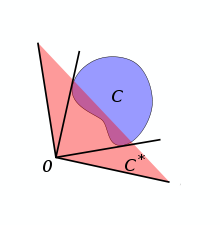- Dual cone and polar cone
-
Dual cone and polar cone are closely related concepts in convex analysis, a branch of mathematics.
Dual cone
The dual cone C * of a subset C in a Euclidean space
 is the set
is the setwhere "·" denotes the dot product.
C * is always a convex cone, even if C is neither convex nor a cone.
When C is a cone, the following properties hold:
- A non-zero vector y is in C * if and only if − y is the normal of a hyperplane that supports C at the origin.
- C * is closed and convex.
 implies
implies  .
.- If C has nonempty interior, then C * is pointed, i.e. C * contains no line in its entirety.
- If C is a cone and the closure of C is pointed, then C * has nonempty interior.
- C * * is the closure of the smallest convex cone containing C.
A cone is said to be self-dual if C = C * . The nonnegative orthant of
 and the space of all positive semidefinite matrices are self-dual.
and the space of all positive semidefinite matrices are self-dual.Dual cones can be more generally defined on real Hilbert spaces.
Polar cone
For a set C in
 the polar cone of C is the set
the polar cone of C is the setIt is easy to check that Co = − C * for any set C in
 and that the polar cone shares many of the properties of the dual cone.
and that the polar cone shares many of the properties of the dual cone.References
- Goh, C. J.; Yang, X.Q. (2002). Duality in optimization and variational inequalities. London; New York: Taylor & Francis. ISBN 0415274796.
- Boltyanski, V. G.; Martini, H., Soltan, P. (1997). Excursions into combinatorial geometry. New York: Springer. ISBN 3540613412.
- Ramm, A.G.; Shivakumar, P.N.; Strauss, A.V. editors (2000). Operator theory and its applications. Providence, R.I.: American Mathematical Society. ISBN 0821819909.
Wikimedia Foundation. 2010.





